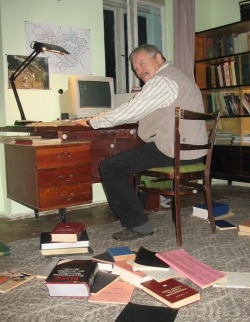Intoductory Survey to the Method of the Alternative Historical Linguistics
Mathematical linguistics, geography, archaeology, mythology, onomastics, ethnography are consolidated in the one project under the common name Alternative Historical Linguistics for the exploration of prehistoric ethnogenetic processes. The main instrument of the research is a special graphic-alalytical method. The essence of this method is quantitative estimation and geometrical interpretation of common characteristics of monophyletic languages in the shape of graphic models on successive chronological levels. These models are constructed on the postulate of the inverse-proportional dependence between the quantity of common words in the pairs of cognate languages and the distance between the areas of forming these languages from the unitary originative language.
The calculation of the quantity of common lexical items in language pairs has been done on the data of Table-dictionaries which were created for each studied language family.
The model of the language relationship looks as a graph which has as so much knots how much of languages are studied. Indeed, each knot looks as an area of points being ends of a segment with length corresponded to the quantity of common words in language pairs. These segments connect pairs of all areas. The construction of the model goes in some approximation.
When the model is ready we try to find a place for it on a geographical map of Eurasia. The form of the model could not be broken therefore it is not easy to find suitable place on the map with the same topological character as the model. Each area of language formation must have distinct borders, which hinder intercourses between inhabitants of these areas and so contribute to forming new separate languages from the previous common one. The borders of the areas can be rivers, mount chains, swamps etc.
To short description
To the whole version of the Alternative Linguistics
The calculation of the quantity of common lexical items in language pairs has been done on the data of Table-dictionaries which were created for each studied language family.
The model of the language relationship looks as a graph which has as so much knots how much of languages are studied. Indeed, each knot looks as an area of points being ends of a segment with length corresponded to the quantity of common words in language pairs. These segments connect pairs of all areas. The construction of the model goes in some approximation.
When the model is ready we try to find a place for it on a geographical map of Eurasia. The form of the model could not be broken therefore it is not easy to find suitable place on the map with the same topological character as the model. Each area of language formation must have distinct borders, which hinder intercourses between inhabitants of these areas and so contribute to forming new separate languages from the previous common one. The borders of the areas can be rivers, mount chains, swamps etc.
To short description
To the whole version of the Alternative Linguistics

